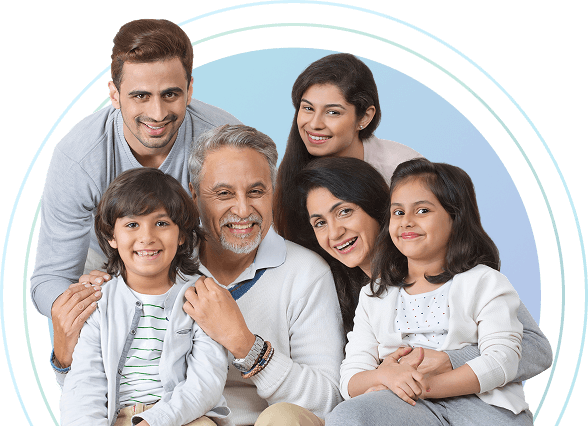ಮಕ್ಕಳಲ್ಲಿ ಸಿಡುಬು ತಡೆಗಟ್ಟುವಿಕೆ: ಲಕ್ಷಣಗಳು ಹಾಗೂ ವೆರಿಸೆಲ್ಲಾ ಲಸಿಕೆ ಮೂಲಕ ರಕ್ಷಣೆ
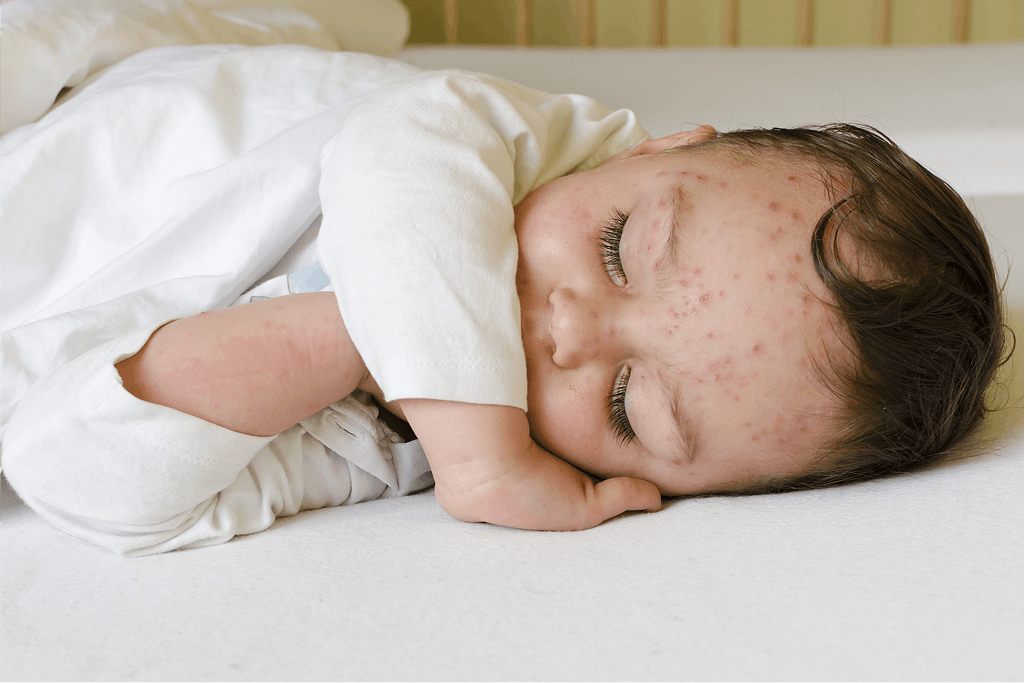
ಕಾಲ್ಪನಿಕ ಚಿತ್ರ, ಉದಾಹರಣೆಯ ಉದ್ದೇಶಗಳಿಗಾಗಿ ಮಾತ್ರ
ಸಿಡುಬು, ವೈದ್ಯಕೀಯವಾಗಿ ವೆರಿಸೆಲ್ಲಾ ಎಂದು ಕರೆಯಲ್ಪಡುತ್ತದೆ1, ಇದು ಹೆಚ್ಚು ಸಾಂಕ್ರಾಮಿಕವಾದ ವೈರಲ್ ಸೋಂಕು ಆಗಿದ್ದು2, ಇದು ಪ್ರಮುಖವಾಗಿ ಮಕ್ಕಳ ಮೇಲೆ ಪರಿಣಾಮ ಬೀರುತ್ತದೆ.1 ಇದನ್ನು ಸಾಮಾನ್ಯವಾಗಿ ಸೌಮ್ಯ ಬಾಲ್ಯದ ಕಾಯಿಲೆ ಎಂದು ಪರಿಗಣಿಸಲಾಗುತ್ತದೆ1, ಆದರೆ ಇದು ಕೆಲವೊಮ್ಮೆ ಗಂಭೀರ ಸಮಸ್ಯೆಗಳಿಗೆ ಕಾರಣವಾಗಬಹುದು ಮತ್ತು ಅಪರೂಪದ ಸಂದರ್ಭಗಳಲ್ಲಿ, ಜೀವಕ್ಕೆ ಅಪಾಯಕಾರಿ ಆಗಬಹುದು1.
ಆದರೂ, ನಿಮ್ಮ ಮಗುವನ್ನು ಸಿಡುಬಿನ ಕಾಯಿಲೆಯಿಂದ ರಕ್ಷಿಸಲು ಒಂದು ಪರಿಣಾಮಕಾರಿ ಮಾರ್ಗವಿದೆ: ಅದೆಂದರೆ ಲಸಿಕೆ1,3. ಸಿಡುಬಿನ ಲಸಿಕೆಯು ವೈರಸ್ನಿಂದ ರಕ್ಷಿಸುತ್ತದೆ, ಅನಿರೀಕ್ಷಿತವಾಗಿ ಕಾಣಿಸಿಕೊಳ್ಳುವ ಮತ್ತು ಸಮಸ್ಯೆಗಳ ಸಾಧ್ಯತೆಗಳನ್ನು ಕಡಿಮೆ ಮಾಡುತ್ತದೆ 1,3.
ಈ ಬ್ಲಾಗ್, ಅದರ ಲಕ್ಷಣಗಳು, ಸಮಸ್ಯೆಗಳು ಮತ್ತು ಈ ಸಾಮಾನ್ಯ ಆದರೆ ತಡೆಗಟ್ಟಬಹುದಾದ ಖಾಯಿಲೆಯಿಂದ ಮಕ್ಕಳನ್ನು ಸುರಕ್ಷಿತವಾಗಿರಿಸುವಲ್ಲಿ ವೆರಿಸೆಲ್ಲಾ ಲಸಿಕೆಯ ಪ್ರಾಮುಖ್ಯತೆಯನ್ನು ಒಳಗೊಂಡಂತೆ ಸಿಡುಬಿನ ವಿವರಗಳನ್ನು ಅನ್ವೇಷಿಸುತ್ತದೆ. ಹೆಚ್ಚಿನ ಮಾಹಿತಿಗಾಗಿ ಓದುವುದನ್ನು ಮುಂದುವರಿಸಿ!
ಸಿಡುಬಿನ ರೋಗದ ಬಗ್ಗೆ ಅರ್ಥಮಾಡಿಕೊಳ್ಳುವುದು
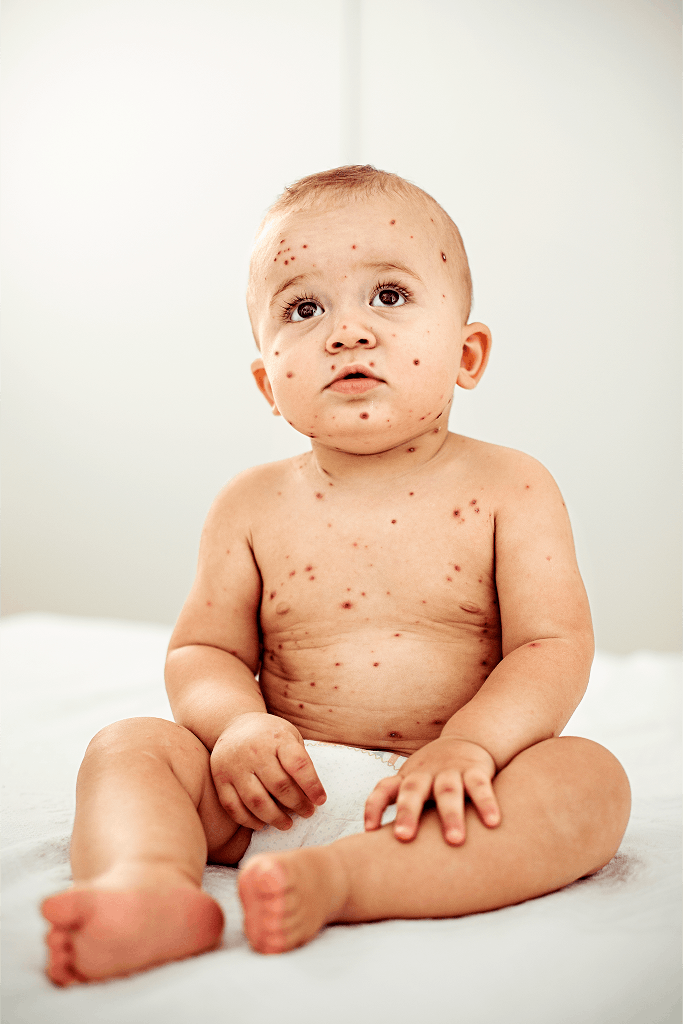
ಕಾಲ್ಪನಿಕ ಚಿತ್ರ, ಉದಾಹರಣೆಯ ಉದ್ದೇಶಗಳಿಗಾಗಿ ಮಾತ್ರ
ಸಿಡುಬು ಒಂದು ತೀವ್ರವಾದ ಸಾಂಕ್ರಾಮಿಕ ಕಾಯಿಲೆಯಾಗಿದ್ದು, ತುರಿಕೆ ಕೆಂಪು ದದ್ದು ಕಾಣಿಸಿಕೊಳ್ಳುತ್ತದೆ ಮತ್ತು ಇದು ಅಂತಿಮವಾಗಿ ದ್ರವ ತುಂಬಿದ ಗುಳ್ಳೆಗಳಾಗಿ ಬೆಳೆಯುತ್ತದೆ. ಈ ಅನಾರೋಗ್ಯವು ಹರ್ಪಿಸ್ ವೈರಸ್ ಕುಟುಂಬಕ್ಕೆ ಸೇರಿದ ಹೆಚ್ಚು ಸಾಂಕ್ರಾಮಿಕ ಡಿಎನ್ಎ ವೈರಸ್ ಆದ ವರಿಸೆಲ್ಲಾ-ಜೋಸ್ಟರ್ ವೈರಸ್ನಿಂದ ಉಂಟಾಗುತ್ತದೆ.1
ವೆರಿಸೆಲ್ಲಾ-ಜೋಸ್ಟರ್ ವೈರಸ್ ವಾಯುಗಾಮಿ ಹನಿಗಳು ಅಥವಾ ನೇರ ಸಂಪರ್ಕದ ಮೂಲಕ ವ್ಯಕ್ತಿಯಿಂದ ವ್ಯಕ್ತಿಗೆ ಹರಡುತ್ತದೆ. ಸೋಂಕಿತ ವ್ಯಕ್ತಿಯು ಉಸಿರಾಡುವಾಗ, ಕೆಮ್ಮಿದಾಗ, ಸೀನುವಾಗ ಅಥವಾ ಮಾತನಾಡುವಾಗ, ವೈರಸ್ ಹೊಂದಿರುವ ಲಾಲಾರಸದ ಸಣ್ಣ ಹನಿಗಳು ಗಾಳಿಯಲ್ಲಿ ಬಿಡುಗಡೆಯಾಗುತ್ತವೆ ಮತ್ತು ಇತರರು ಅದನ್ನು ಉಸಿರಾಡಬಹುದು, ಇದು ಸೋಂಕಿಗೆ ಕಾರಣವಾಗುತ್ತದೆ. ಸೋಂಕಿತ ವ್ಯಕ್ತಿಯ ಗುಳ್ಳೆಗಳಿಂದ ದ್ರವವನ್ನು ಸ್ಪರ್ಶಿಸುವ ಮೂಲಕವೂ ಸಿಡುಬು ಹರಡಬಹುದು 1,2.
ನೀವು ಲಸಿಕೆ ಹಾಕಿಸಿಕೊಂಡಿಲ್ಲದಿದ್ದರೆ ಅಥವಾ ಈ ಮೊದಲು ರೋಗವನ್ನು ಹೊಂದಿರದಿದ್ದರೆ ಸಿಡುಬು ಇರುವ ವ್ಯಕ್ತಿಯೊಂದಿಗೆ ಸಮೀಪದ ಸಂಪರ್ಕವು ಸೋಂಕಿಗೆ ಕಾರಣವಾಗಬಹುದು1.
ಸಿಡುಬು ಖಾಯಿಲೆ ಹೊಂದಿರುವ ವ್ಯಕ್ತಿಯು ದದ್ದು ಕಾಣಿಸಿಕೊಳ್ಳುವ 1 ರಿಂದ 2 ದಿನಗಳ ಮೊದಲಿನಿಂದ ಎಲ್ಲಾ ಗುಳ್ಳೆಗಳು ಹಕ್ಕಳೆ ಬಿಡುವ ತನಕ ಸಾಂಕ್ರಾಮಿಕವಾಗಿರುತ್ತಾನೆ1. ಈ ರೋಗವು ಹೆಚ್ಚು ಸಾಮಾನ್ಯವಾಗಿ 1 ರಿಂದ 9 ವರ್ಷ ವಯಸ್ಸಿನ ಮಕ್ಕಳ ಮೇಲೆ ಪರಿಣಾಮ ಬೀರುತ್ತದೆಯಾದರೂ, ಹಿರಿಯ ಮಕ್ಕಳು, ವಯಸ್ಕರು ಮತ್ತು ಲಸಿಕೆ ಹಾಕಿಸಿಕೊಳ್ಳದ ವ್ಯಕ್ತಿಗಳು ಜೀವನದಲ್ಲಿ ಮೊದಲೇ ಸಿಡುಬು ಹೊಂದಿರದಿದ್ದರೆ ಅಪಾಯದಲ್ಲಿರುತ್ತಾರೆ 1.
ಸಾಮಾನ್ಯವಾಗಿ, ಸಿಡುಬು ಸುಮಾರು 5 ರಿಂದ 7 ದಿನಗಳವರೆಗೆ ಇರುತ್ತದೆ 1. ಆದರೂ, ಕೆಲವು ಸಂದರ್ಭಗಳಲ್ಲಿ, ಇದು ನ್ಯುಮೋನಿಯಾ, ಬ್ಯಾಕ್ಟೀರಿಯಾದ ಸೋಂಕುಗಳು, ಮೆದುಳಿನ ಉರಿಯೂತ (ಎನ್ಸೆಫಾಲಿಟಿಸ್), ನಿರ್ಜಲೀಕರಣ ಅಥವಾ ರಕ್ತಪ್ರವಾಹದ ಸೋಂಕುಗಳು (ಸೆಪ್ಸಿಸ್) ನಂತಹ ಗಂಭೀರ ತೊಡಕುಗಳಿಗೆ ಕಾರಣವಾಗಬಹುದು 1,2. ಈ ತೊಡಕುಗಳು ಇವರುಗಳನ್ನು ಒಳಗೊಂಡಂತೆ ಹೆಚ್ಚಿನ ಅಪಾಯದ ಗುಂಪುಗಳಲ್ಲಿ ಕಂಡುಬರುವ ಸಾಧ್ಯತೆ ಹೆಚ್ಚು 1,2:
ಅವಧಿಗೆ ಮೊದಲೇ ಜನಿಸಿದ ಶಿಶುಗಳು
ಶಿಶುಗಳು
ಅಪ್ರಾಪ್ತರು
ವಯಸ್ಕರು
ಗರ್ಭಿಣಿಯರು
ದುರ್ಬಲ ರೋಗನಿರೋಧಕ ವ್ಯವಸ್ಥೆ ಹೊಂದಿರುವ ವ್ಯಕ್ತಿಗಳು
ಲಸಿಕೆ ಹಾಕುವುದರಿಂದ ಸಿಡುಬಿನ ಖಾಯಿಲೆ ಬರುವ ಅಪಾಯ ಮತ್ತು ತೀವ್ರ ಲಕ್ಷಣಗಳು ಅಥವಾ ತೊಡಕುಗಳನ್ನು ಅನುಭವಿಸುವ ಸಾಧ್ಯತೆ ಕಡಿಮೆಯಾಗುತ್ತದೆ, ಇದು ನಿಮ್ಮ ಮಗು ಮತ್ತು ಅವರ ಸುತ್ತಮುತ್ತಲಿನವರನ್ನು ರಕ್ಷಿಸಲು ಸಹಾಯ ಮಾಡುತ್ತದೆ 1,3.
ಸಿಡುಬಿನ ರೋಗದ ಸಾಮಾನ್ಯ ಲಕ್ಷಣಗಳು
ಸಿಡುಬಿನ ಖಾಯಿಲೆಯ ಸರಾಸರಿ ಇನ್ ಕ್ಯುಬೇಶನ್ ಕಾಲಾವಧಿ, ಎಂದರೆ ವೈರಸ್ಗೆ ಒಡ್ಡಿಕೊಳ್ಳುವುದರಿಂದ ಮತ್ತು ರೋಗಲಕ್ಷಣಗಳು ಕಾಣಿಸಿಕೊಳ್ಳುವ ನಡುವಿನ ಸಮಯ, 14 ರಿಂದ 15 ದಿನಗಳವರೆಗೆ ಇರುತ್ತದೆ. ಆದರೂ, ಒಡ್ಡಿಕೊಂಡ ನಂತರ 10 ರಿಂದ 21 ದಿನಗಳಲ್ಲಿ ಎಲ್ಲಿಯಾದರೂ ರೋಗಲಕ್ಷಣಗಳು ಕಾಣಿಸಿಕೊಳ್ಳಬಹುದು1.
ಸಿಡುಬಿನ ಪ್ರಾಥಮಿಕ ಚಿಹ್ನೆಯೆಂದರೆ ದದ್ದು, ಇದು ತುರಿಕೆ, ದ್ರವ ತುಂಬಿದ ಗುಳ್ಳೆಗಳಾಗಿ ವಿಕಸನಗೊಳ್ಳುತ್ತದೆ, ಇದು ಅಂತಿಮವಾಗಿ ಹಕ್ಕಳೆಗಳನ್ನು ರೂಪಿಸುತ್ತದೆ. ದದ್ದು ಸಾಮಾನ್ಯವಾಗಿ ಎದೆ, ಬೆನ್ನು ಮತ್ತು ಮುಖದ ಮೇಲೆ ಪ್ರಾರಂಭವಾಗುತ್ತದೆ, ನಂತರ ಬಾಯಿ, ಕಣ್ಣುರೆಪ್ಪೆಗಳು, ನೆತ್ತಿ, ಕೈಗಳು ಮತ್ತು ಕಾಲುಗಳು ಸೇರಿದಂತೆ ಇಡೀ ದೇಹಕ್ಕೆ ಹರಡುತ್ತದೆ. ಕೆಲವೊಮ್ಮೆ, ಲೋಳೆಯ ಪೊರೆಗಳು ಮತ್ತು ಜನನಾಂಗದ ಪ್ರದೇಶದ ಮೇಲೂ ಪರಿಣಾಮ ಬೀರಬಹುದು 1,2.
ಸಿಡುಬು ಇರುವ ವ್ಯಕ್ತಿಯಲ್ಲಿ 1000 ಕ್ಕೂ ಹೆಚ್ಚು ಗಾಯಗಳು ಬೆಳೆಯಬಹುದು1, ಮತ್ತು ಅವೆಲ್ಲವೂ ಒಂದರಲ್ಲಿ ಹುಣ್ಣಾಗಲು ಸಾಮಾನ್ಯವಾಗಿ ಒಂದರಿಂದ ಎರಡು ವಾರಗಳು ಬೇಕಾಗುತ್ತದೆ1.
ಇದರ ಜೊತೆಗೆ, ದದ್ದು ಕಾಣಿಸಿಕೊಳ್ಳುವ 1 ರಿಂದ 2 ದಿನಗಳ ಮೊದಲು ಕೆಲವು ಇತರ ಲಕ್ಷಣಗಳು ಕಾಣಿಸಿಕೊಳ್ಳಬಹುದು, ಅವುಗಳಲ್ಲಿ ಈ ಕೆಳಗಿನವುಗಳು ಸೇರಿವೆ2:
ಅಲ್ಪ ಜ್ವರ
ಮೂಗು ಸುರಿಯುವುದು ಮತ್ತು ಕೆಮ್ಮು
ಆಯಾಸ ಅಥವಾ ಸುಸ್ತು
ತಲೆನೋವು
ಸಿಡುಬು ಸಾಮಾನ್ಯವಾಗಿ ಸೌಮ್ಯವಾಗಿದ್ದು 1,2, ಇದು ವಿಶೇಷವಾಗಿ ಹೆಚ್ಚಿನ ಅಪಾಯದ ವ್ಯಕ್ತಿಗಳಲ್ಲಿ ಗಂಭೀರ ತೊಡಕುಗಳಿಗೆ ಕಾರಣವಾಗಬಹುದು 1. ಆರೋಗ್ಯವಂತ ವ್ಯಕ್ತಿಗಳಲ್ಲಿ ಈ ತೊಡಕುಗಳು ಅಪರೂಪವಾಗಿದ್ದರೂ, ಇವುಗಳನ್ನು ಒಳಗೊಂಡಿರಬಹುದು1:
ಗುಂಪು ಎ ಸ್ಟ್ರೆಪ್ಟೋಕೊಕಲ್ ಸೋಂಕುಗಳಂತಹ ಚರ್ಮ ಮತ್ತು ಮೃದು ಅಂಗಾಂಶಗಳ ಬ್ಯಾಕ್ಟೀರಿಯಾದ ಸೋಂಕುಗಳು
ಶ್ವಾಸಕೋಶದ ಸೋಂಕುಗಳು (ನ್ಯುಮೋನಿಯಾ)
ಮೆದುಳಿನ ಸೋಂಕು ಅಥವಾ ಉರಿಯೂತ (ಎನ್ಸೆಫಲೈಟಿಸ್, ಸೆರೆಬ್ರೆಲಾರ್ ಅಟಾಕ್ಸಿಯಾ)
ರಕ್ತಸ್ರಾವದ ಸಮಸ್ಯೆಗಳು (ರಕ್ತಸ್ರಾವದ ಅಪಾಯಗಳು)
ಸೆಪ್ಸಿಸ್
ನಿರ್ಜಲೀಕರಣ
ತೀವ್ರ ಪ್ರಕರಣಗಳಲ್ಲಿ, ಸಿಡುಬಿಗೆ ಆಸ್ಪತ್ರೆಗೆ ದಾಖಲಿಸುವುದು ಅಗತ್ಯವಾಗಬಹುದು ಮತ್ತು ಅದು ಮಾರಕವಾಗಬಹುದು 1.
ಗರ್ಭಾವಸ್ಥೆಯ ಮೊದಲ ಆರು ವಾರಗಳಲ್ಲಿ ಮಹಿಳೆಗೆ ಸಿಡುಬು ಬಂದರೆ, ಅದು ಹುಟ್ಟಲಿರುವ ಮಗುವಿನಲ್ಲಿ ಗಂಭೀರ ಅಸಹಜತೆಗಳಿಗೆ ಕಾರಣವಾಗಬಹುದು. ಹೆರಿಗೆಯ ದಿನಾಂಕದ ಹತ್ತಿರ ಸೋಂಕು ತಗುಲಿದರೆ ಮಗುವಿನ ಜೀವಕ್ಕೆ ಅಪಾಯಕಾರಿ, ಏಕೆಂದರೆ ಅದರ ರೋಗನಿರೋಧಕ ಶಕ್ತಿ ಇನ್ನೂ ಸಂಪೂರ್ಣವಾಗಿ ಅಭಿವೃದ್ಧಿ ಹೊಂದಿರುವುದಿಲ್ಲ 1.
ಸಿಡುಬಿನ ಮತ್ತೊಂದು ಸಂಭಾವ್ಯ ತೊಡಕು ಎಂದರೆ ಶಿಂಗಲ್ಸ್ ಅಥವಾ ಹರ್ಪಿಸ್ ಜೋಸ್ಟರ್. ಸಿಡುಬಿನಿಂದ ಚೇತರಿಸಿಕೊಂಡ ನಂತರ, ವೆರಿಸೆಲ್ಲಾ-ಜೋಸ್ಟರ್ ವೈರಸ್ ದೇಹದ ಸಂವೇದನಾ ನರ ಗ್ಯಾಂಗ್ಲಿಯಾದಲ್ಲಿ ಸುಪ್ತವಾಗಿರುತ್ತದೆ. ವೈರಸ್ ವರ್ಷಗಳ ನಂತರವೂ ಪುನಃ ಸಕ್ರಿಯಗೊಳ್ಳಬಹುದು, ಇದು ಶಿಂಗಲ್ಸ್ಗೆ (ಸರ್ಪಸುತ್ತು) ಕಾರಣವಾಗುತ್ತದೆ, ಇದು ನೋವಿನ ದದ್ದುಗಳ ಗುಣಲಕ್ಷಣಗಳನ್ನು ಹೊಂದಿದೆ. ಶಿಂಗಲ್ಸ್ ಹೊಂದಿರುವ ವಯಸ್ಕರು ರೋಗನಿರೋಧಕ ಶಕ್ತಿ ಇಲ್ಲದ ಇತರರಿಗೆ ವೈರಸ್ ಅನ್ನು ಹರಡಬಹುದು, ಇದು ಅವರಲ್ಲಿ ಸಿಡುಬು ಬೆಳವಣಿಗೆ ಹೊಂದಲು ಕಾರಣವಾಗಬಹುದು1.
ಸಿಡುಬು ರೋಗವನ್ನು ತಡೆಗಟ್ಟುವಲ್ಲಿ ವೆರಿಸೆಲ್ಲಾ ಲಸಿಕೆಯ ಪಾತ್ರ
ಸಿಡುಬಿನಿಂದ ಮಕ್ಕಳನ್ನು ರಕ್ಷಿಸಲು ಪರಿಣಾಮಕಾರಿ ಮಾರ್ಗವೆಂದರೆ ವರಿಸೆಲ್ಲಾ ಲಸಿಕೆ 1,3. ಲಸಿಕೆಯು ರೋಗನಿರೋಧಕ ವ್ಯವಸ್ಥೆಯನ್ನು ದುರ್ಬಲಗೊಂಡ ವೈರಸ್ಗೆ ಒಡ್ಡುವ ಮೂಲಕ ಕಾರ್ಯನಿರ್ವಹಿಸುತ್ತದೆ, ದೇಹವು ಅನಾರೋಗ್ಯಕ್ಕೆ ಕಾರಣವಾಗದೆ ರೋಗನಿರೋಧಕ ಶಕ್ತಿಯನ್ನು ಬೆಳೆಸಿಕೊಳ್ಳಲು ಅವಕಾಶ ನೀಡುತ್ತದೆ 4.
ಸಿಡುಬಿನ ಲಸಿಕೆ ಪರಿಣಾಮಕಾರಿಯಾಗಿದೆ - ಎರಡು ಡೋಸ್ಗಳನ್ನು ಪಡೆಯುವ 90% ಕ್ಕಿಂತ ಹೆಚ್ಚು ಮಕ್ಕಳು ವೈರಸ್ನಿಂದ ರಕ್ಷಿಸಲ್ಪಡುತ್ತಾರೆ 3. ಲಸಿಕೆ ಹಾಕಿದ ಮಕ್ಕಳು ವೈರಸ್ಗೆ ಒಳಗಾದ ಬ್ರೇಕ್ಥ್ರೂ ಚಿಕನ್ಪಾಕ್ಸ್ ಎಂದು ಕರೆಯಲ್ಪಡುವ ಸಂದರ್ಭಗಳಲ್ಲಿ ಅನಾರೋಗ್ಯವು ಸಾಮಾನ್ಯವಾಗಿ ಸೌಮ್ಯವಾಗಿರುತ್ತದೆ. ಈ ಮಕ್ಕಳು ಸಾಮಾನ್ಯವಾಗಿ ಕಡಿಮೆ ಅಥವಾ ಯಾವುದೇ ಗುಳ್ಳೆಗಳನ್ನು ಅನುಭವಿಸುವುದಿಲ್ಲ ಮತ್ತು ಕನಿಷ್ಠ ಜ್ವರವನ್ನು ಅನುಭವಿಸುತ್ತಾರೆ, ಆದರೂ ಕೆಲವು ಕೆಂಪು ಚುಕ್ಕೆಗಳು ಇನ್ನೂ ಕಾಣಿಸಿಕೊಳ್ಳಬಹುದು 2,3.
ಸಿಡುಬಿನ ಲಸಿಕೆಯನ್ನು ಎರಡು ಡೋಸ್ಗಳಲ್ಲಿ ನೀಡಲಾಗುತ್ತದೆ:5
15 ನೇ ತಿಂಗಳಿನಲ್ಲಿ ಮೊದಲ ಡೋಸ್
18 ಮತ್ತು 24 ತಿಂಗಳ ನಡುವೆ ಎರಡನೆಯ ಡೋಸ್
ಹೆಚ್ಚುವರಿಯಾಗಿ, ಲಸಿಕೆಯು ಸಿಡುಬಿಗೆ ಸಂಬಂಧಿಸಿದ ಸಂಭಾವ್ಯ ಸಮಸ್ಯೆಗಳನ್ನು ತಡೆಯಲು ಸಹಾಯ ಮಾಡುತ್ತದೆ1,2.
7-ಸ್ಟಾರ್ ಲಸಿಕೆ ಕಾರ್ಯಕ್ರಮವು IAP ಸಲಹಾ ಸಮಿತಿಯ ಲಸಿಕೆ ಮತ್ತು ರೋಗನಿರೋಧಕ ಅಭ್ಯಾಸಗಳು (ACVIP) 5 ರ ಮಾರ್ಗಸೂಚಿಗಳನ್ನು ಆಧರಿಸಿದ ಸಮಗ್ರ ಮತ್ತು ಉತ್ತಮವಾಗಿ ರಚನಾತ್ಮಕ ವೇಳಾಪಟ್ಟಿಯಾಗಿದೆ. ಇದು ಚಿಕನ್ಪಾಕ್ಸ್, ಹೆಪಟೈಟಿಸ್ ಎ, ಫ್ಲೂ, ರುಬೆಲ್ಲಾ, ಮಂಪ್ಸ್, ಮೆನಿಂಜೈಟಿಸ್ ಮತ್ತು ಇನ್ನೂ ಹೆಚ್ಚಿನವುಗಳನ್ನು ಒಳಗೊಂಡಂತೆ ಹದಿನಾಲ್ಕು ವಿಭಿನ್ನ ಕಾಯಿಲೆಗಳಿಗೆ ರಕ್ಷಣೆಯನ್ನು ಒಳಗೊಂಡಿರುವ ಏಳು ಪ್ರಮುಖ ಲಸಿಕೆಗಳನ್ನು ಸೇರಿಸುವ ಮೂಲಕ ವ್ಯಾಪಕ ಶ್ರೇಣಿಯ ತಡೆಗಟ್ಟಬಹುದಾದ ರೋಗಗಳ ವಿರುದ್ಧ ರಕ್ಷಣೆ ನೀಡುತ್ತದೆ.
ವಿವರವಾದ ಮಾಹಿತಿಗಾಗಿ ಮತ್ತು ನಿಮ್ಮ ಮಗುವಿಗೆ 7-ಸ್ಟಾರ್ ಪ್ರೊಟೆಕ್ಷನ್ ವೇಳಾಪಟ್ಟಿ ಸಿಗುತ್ತಿದೆಯೇ ಎಂದು ಖಚಿತಪಡಿಸಿಕೊಳ್ಳಲು, ನಿಮ್ಮ ಮಕ್ಕಳ ವೈದ್ಯರನ್ನು ಸಂಪರ್ಕಿಸಿ.
ಸಮಾಪ್ತಿ
ಸಿಡುಬು ಹೆಚ್ಚು ಸಾಂಕ್ರಾಮಿಕ ಆದರೆ ತಡೆಗಟ್ಟಬಹುದಾದ ಕಾಯಿಲೆಯಾಗಿದ್ದು, ಇದು ಸಾಮಾನ್ಯವಾಗಿ ಮಕ್ಕಳ ಮೇಲೆ ಪರಿಣಾಮ ಬೀರುತ್ತದೆ1,2. ಲಕ್ಷಣಗಳು ಮತ್ತು ತೊಡಕುಗಳನ್ನು ಅರ್ಥಮಾಡಿಕೊಳ್ಳುವ ಮೂಲಕ ಮತ್ತು ತಡೆಗಟ್ಟುವ ಕ್ರಮಗಳನ್ನು ತೆಗೆದುಕೊಳ್ಳುವ ಮೂಲಕ, ಪೋಷಕರು ತಮ್ಮ ಮಕ್ಕಳನ್ನು ಸಿಡುಬಿಗೆ ಸಂಬಂಧಿಸಿದ ಅಸ್ವಸ್ಥತೆ ಮತ್ತು ಅಪಾಯಗಳಿಂದ ರಕ್ಷಿಸಬಹುದು.
ಸಿಡುಬಿನ ಲಸಿಕೆಯು ರೋಗದ ಹರಡುವಿಕೆಯನ್ನು ಪರಿಣಾಮಕಾರಿಯಾಗಿ ಕಡಿಮೆ ಮಾಡುತ್ತದೆ ಮತ್ತು ಗಂಭೀರ ಸಮಸ್ಯೆಗಳನ್ನು ತಡೆಯುತ್ತದೆ 1,2,3. ನಿಮ್ಮ ಮಗುವಿಗೆ ನಿಗದಿತ ಸಮಯದಲ್ಲಿ ಲಸಿಕೆಗಳನ್ನು ಪಡೆಯುವುದನ್ನು ಖಚಿತಪಡಿಸಿಕೊಳ್ಳಲು ಮತ್ತು ಸಿಡುಬಿನ ರೋಗವನ್ನು ತಡೆಗಟ್ಟುವ ಬಗ್ಗೆ ನಿಮಗೆ ಇರುವ ಯಾವುದೇ ಕಳವಳಗಳನ್ನು ಚರ್ಚಿಸಲು ನಿಮ್ಮ ಮಕ್ಕಳ ವೈದ್ಯರನ್ನು ಸಂಪರ್ಕಿಸಲು ಮರೆಯದಿರಿ.
References
- Heininger U, Seward JF, (KC). Varicella. The Lancet 2006; 368:1365–1376.
- c=AU, & o=The State of Queensland. (n.d.). Chickenpox (varicella). Gov.au. Retrieved January 10, 2025, from https://www.qld.gov.au/health/condition/infections-and-parasites/viral-infections/chickenpox-varicella
- (N.d.). Hhs.gov. Retrieved January 10, 2025, from https://www.hhs.gov/immunization/diseases/chickenpox/index.html
- CDC. (2024, August 10). Explaining how vaccines work. Vaccines & Immunizations. https://www.cdc.gov/vaccines/basics/explaining-how-vaccines-work.html?CDC_AA_refVal=https%3A%2F%2Fwww.cdc.gov%2Fvaccines%2Fhcp%2Fconversations%2Funderstanding-vacc-work.html
- Indra M, Kasi SG, Shashi Kant Dhir, Wadhwa A, B. Rajsekhar, Chandra Mohan Kumar, et al. Indian Academy of Pediatrics (IAP) Advisory Committee on Vaccines and Immunization Practices (ACVIP): Recommended Immunization Schedule (2023) and Update on Immunization for Children Aged 0 Through 18 Years. Indian pediatrics/Indian Pediatrics. 2024 Jan 15;61(2):113–25.
CL code: NP-IN-PVU-WCNT-240014 DoP: Jan 2025
ಹೆಚ್ಚು ಓದಿ
-
ಶಿಶುಗಳು ಮತ್ತು ಚಿಕ್ಕ ಮಕ್ಕಳಲ್ಲಿ ಇನ್ಫ್ಲುಯೆಂಜಾ ತಡೆಗಟ್ಟುವಿಕೆ: ಪೋಷಕರಾಗಿ ನೀವು ಏನು ಮಾಡಬಹುದು?
19-03-2025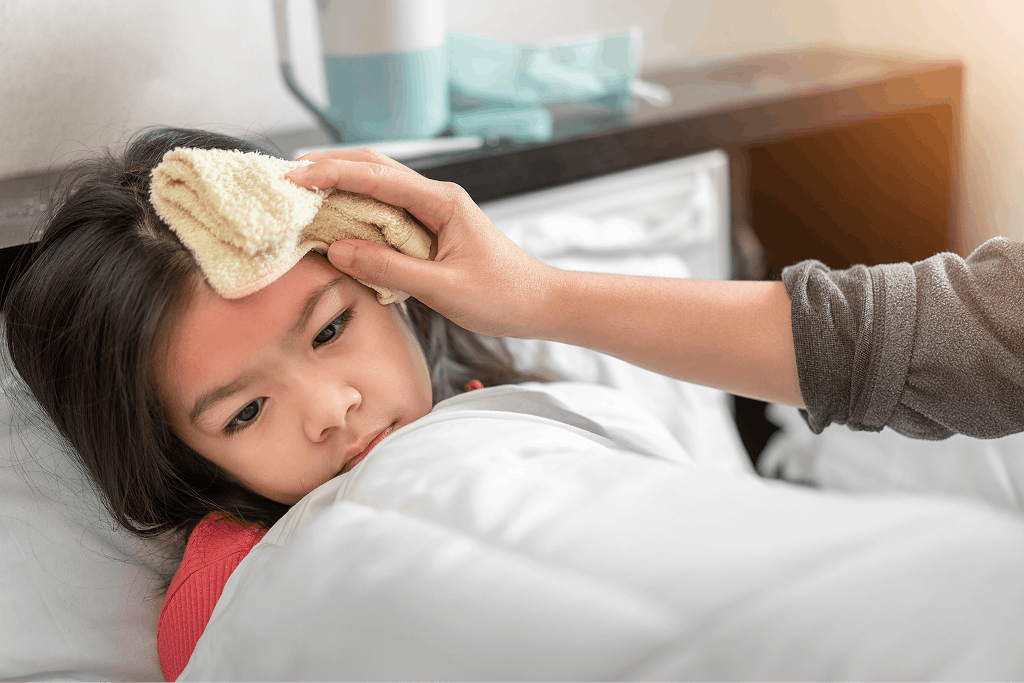 Read more »
Read more »
-
ಮಂಗನಬಾವು (ಮಂಪ್ಸ್) ಬಗ್ಗೆ ಅರ್ಥಮಾಡಿಕೊಳ್ಳುವುದು ಮತ್ತು ಅದರ ಹರಡುವಿಕೆಯಿಂದ ಮಕ್ಕಳನ್ನು ಹೇಗೆ ರಕ್ಷಿಸುವುದು
19-03-2025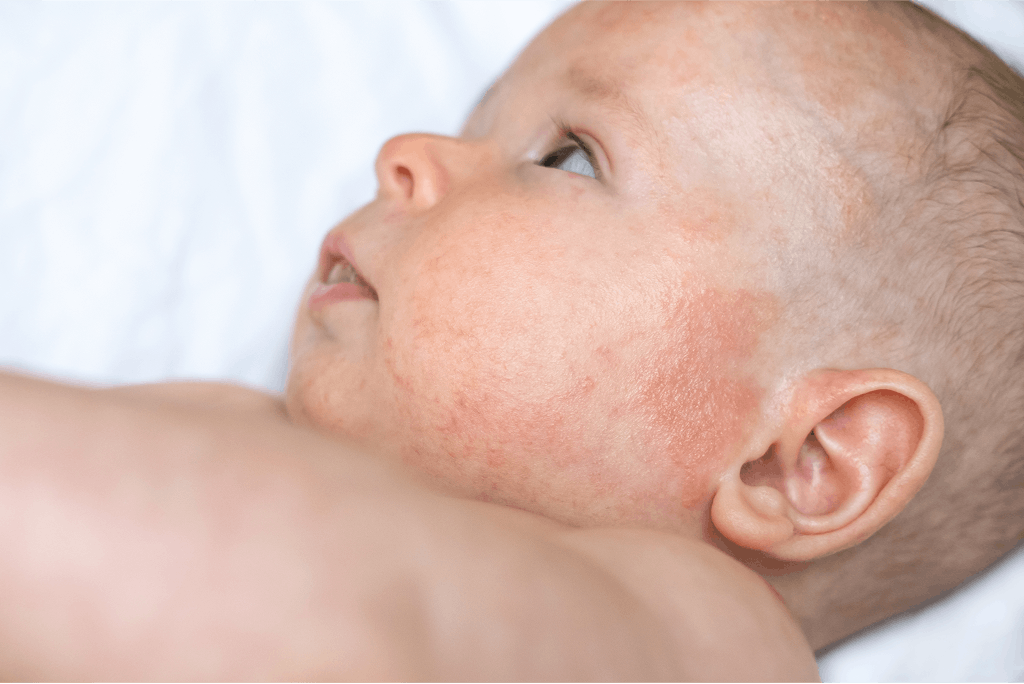 Read more »
Read more »
